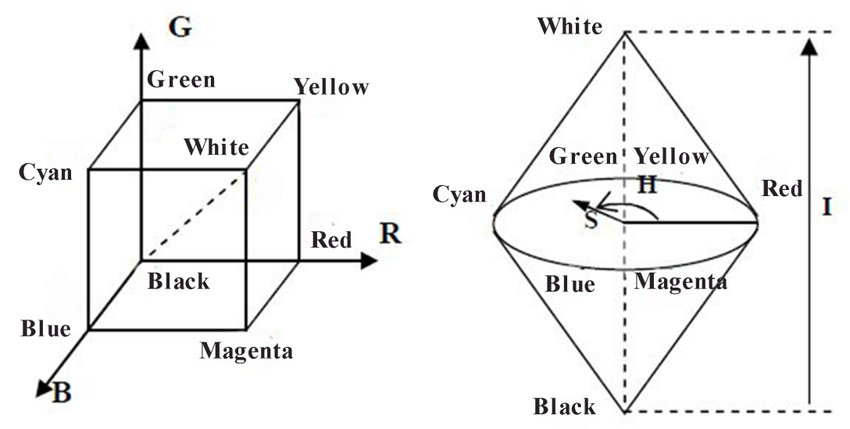HSI Color Model
The creation colors in the RGB, CMY, and CMYK models are simple, as is switching between them. These color systems are excellent candidates for hardware implementation. Furthermore, the RGB system corresponds well with the fact that the human eye is highly sensitive to red, green, and blue primaries. Unfortunately, the RGB, CMY, and other similar color models are not well suited to describing colors in terms that are easily understood by humans. For example, one does not refer to the color of a car by specifying the percentage of each of its primaries. Furthermore, we do not consider color images to be made up of three primary images that are combined to form a single image.
We describe a color by its hue, saturation, and brightness when we look at it. Hue describes a pure color (pure yellow, orange, or red), whereas saturation indicates how much a pure color is diluted by white light. Brightness is a subjective and difficult to quantify descriptor. It is a key factor in describing color sensation and represents the achromatic concept of intensity. We know that intensity (grey level) is an excellent achromatic image descriptor. This number is unequivocally measurable and easily interpretable. The HSI (hue, saturation, intensity) color model that we are about to present decouples the intensity component of a color image from the color-carrying information (hue and saturation). As a result, the HSI model is an effective tool for developing image processing algorithms that are natural and intuitive to humans, who are, after all, the creators and users of these algorithms.
To summarise, RGB is ideal for image color generation, but its application for color description is much more limited. The material that follows explains how to do so effectively.

Figure: Relationships between the RGB and HSI color models
An RGB value can also be used to calculate the hue. In above image depicts a plane defined by three points (black, white, and cyan). Because the black and white points are contained in the plane, we can conclude that the intensity axis is also contained in the plane. Furthermore, we can see that all points within the plane segment defined by the intensity axis and the cube's boundaries have the same hue (cyan in this case). We could reach the same conclusion by remembering from Section 6.1 that all colors generated by three colors are contained within the triangle defined by those colors. Because the black and white components cannot change the hue, all points on the triangle will have the same hue if two of those points are black and white and the third is a color point (of course, the intensity and saturation of points in this triangle would be different). We could get different hues by rotating the shaded plane around the vertical intensity axis. We can deduce from these ideas that the hue, saturation, and intensity values required to form the HSI space can be obtained from the RGB color cube. That is, we can use the formulas described in the preceding discussion to convert any RGB point to a corresponding point in the HSI color space.